15 German Dishes You Need To Try At Least Once
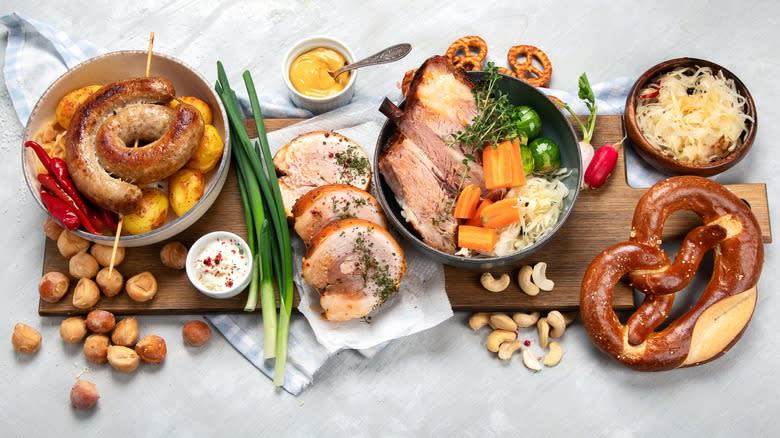
Known for being robust and hearty, with rich flavors, German cuisine is a blend of age-old traditions rooted in the country's various regions, with modern culinary innovation that has evolved as recipes were passed through generations. The charm of German food lies in its authenticity, with each region boasting its own specialties and traditional dishes, showcasing the unique flavors and ingredients of the area. This means that what you find in southern Germany will differ from the dishes enjoyed in northern Germany. Moreover, with culinary inspiration pulled from Polish, Jewish, and Turkish influences, the cuisine of this country is something truly unique.
German food contains a few distinctive favorite ingredients like potatoes, sausages, and the famous sauerkraut. This meat-and-potatoes cuisine isn't too far away from other kinds of home cooking cherished around the world, albeit with some distinctive local culinary techniques and flavors. Whether savoring a crispy schnitzel, indulging in the sweetness of apfelstrudel, or relishing the warmth of potato pancakes, German cuisine offers a kind of comfort food for just about anyone while never straying too far from classic traditional fare. Even among the more familiar dishes, like pasta or dumplings, you can expect a distinctly German twist, setting their food traditions apart from others. Here, we'll explore some popular German dishes that you should absolutely add to your culinary bucket list.
Read more: French Cooking Tricks You Need In Your Life
Käsespätzle (Pasta With Cheese)
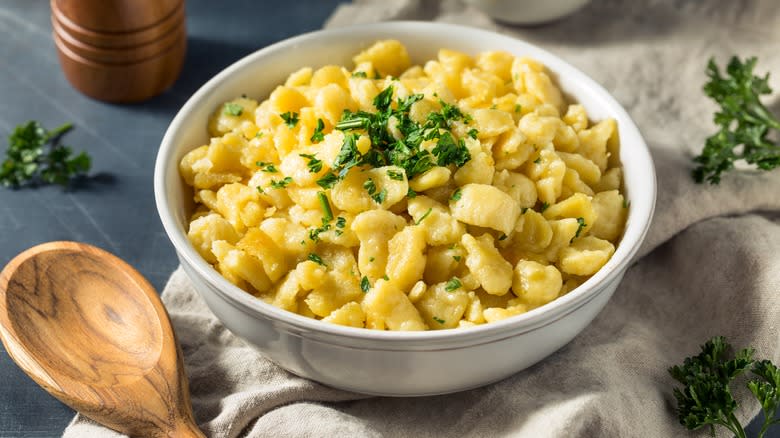
Often hailed as the German equivalent of macaroni and cheese, the spätzle in käsespätzle is a kind of pasta, originally from the southwestern region of Germany, called Swabia (or Schwaben in German). It encompasses parts of Bavaria and Baden-Württemberg. A blend of both German and Austrian cuisine, spätzle was first seen as early as the 1700s. Käse simply means "cheese," but there are several other variations of this pasta dish, from kräuterspätzle (herbed spätzle) to jägerspätzle (mushroom spätzle). In particular, käsespätzle is made from soft egg noodles, melted cheese, and caramelized onions.
The spätzle itself, also spelled spaetzle, is a type of egg noodle that's thicker and chewier than Italian-style pasta. Oftentimes, spätzle is eaten as a side dish much like rice or potatoes. Stemming from the word "spatz," it's thought to literally mean either "little sparrows" or "clump" in the German language — either way, the name refers to their squiggly shape. These noodles are prepared by mixing flour, eggs, salt, and a dash of sparkling water, resulting in a sticky dough that's then dropped into boiling water. When preparing käsespätzle, the cooked noodles are layered with grated cheese, usually Emmental or Gruyère, and fried onions, then baked until golden brown.
Schnitzel (Fried Meat Cutlets)

If you've ever been out to Oktoberfest or encountered German food in your town, you've likely heard of schnitzel. Popular in both German and Austrian cuisine, this quintessential dinner food is a balance of hearty flavor and simplicity. Translated, schnitzel means "cutlets," referring to thinly sliced or pounded meat. These cutlets are coated in breadcrumbs and fried until golden and crispy to make schnitzel. Some compare it to a German version of chicken fried steak, and that's a decent way to look at it, except that schnitzel is typically made of pork, veal (weiner schnitzel), chicken (hähnchenschnitzel), or turkey (putenschnitzel).
The process of making schnitzel is both familiar and straightforward. It involves dipping tenderized cutlets in flour, followed by beaten eggs, and then coating them with breadcrumbs, which are often seasoned with salt, pepper, and herbs. Just like at home, right? The schnitzel is then shallow-fried or pan-fried in hot oil or butter until it gets a golden, crispy crust. Often, it's served with a slice of lemon, providing a tangy contrast to the fried goodness. Accompaniments vary, but it's commonly paired with some sort of salad, vegetables, fried potatoes, or spätzle.
Maultaschen (Stuffed Pasta)

While its name literally translates to "mouth bags," maultaschen is basically the German version of ravioli or stuffed pasta. The dish came out of the Schwaben region, where they were eaten during Lent. Originally, it was considered a resourceful food that poorer families prepared because it conserved meat and put leftovers to good use. During Lent, this pasta was also a way for some people to sneakily enjoy a little of the meat that they were not meant to be eating. In medieval times, meat was forbidden during, but some crafty monks would hide it inside this pasta, disguised with plentiful green leafy vegetables.
The filling of maultaschen typically uses ground meats, such as bratwurst, bacon, or beef, mixed with finely chopped spinach, onions, and a medley of herbs and spices from nutmeg to parsley. The mixture is generously spooned onto the pasta sheets, folded over, and formed into the characteristic "mouth bags." Traditionally, the Schwaben method of cooking uses beef broth to cook maultaschen, while the modern stuffed pasta is eaten outside of Lent and includes a variety of stuffings, much like any other ravioli. The main difference with ravioli comes down to historical tradition, which isn't quite as relevant to the dish today, and their size. Maultaschen is rather larger than typical ravioli, and instead of coming in a sauce, it's usually served in a broth or pan-fried.
Apfelstrudel (Apple Strudel)

Even though apfelstrudel came from Austria, with early recipes dating back to 1697, Germans have wholeheartedly adopted and embraced this delectable pastry into their cuisine. Perhaps its Viennese roots are why it's sometimes considered a lesser-known German dessert. Still, with German being Austria's official language, apfelstrudel still has a German name, literally translating as "apple whirlpool," which refers to the characteristically swirled shape of the pastry.
While strudel comes in many versions, apfelstrudel is a flaky pastry filled with spiced apples that are both sweet and tart, with sugar, cinnamon, nuts, and sometimes raisins or lemon. The dough, rolled out thinly, is crucial to the strudel's structure — this gives the finished pastry its signature light crispness. The meticulously thin and flaky texture is much like other pastries, such as baklava, but phyllo pastry isn't required to make strudel. Served warm and sometimes dusted with powdered sugar, apfelstrudel is typically accompanied by a scoop of vanilla ice cream or a dollop of fresh cream.
Currywurst (Curried Sausage)
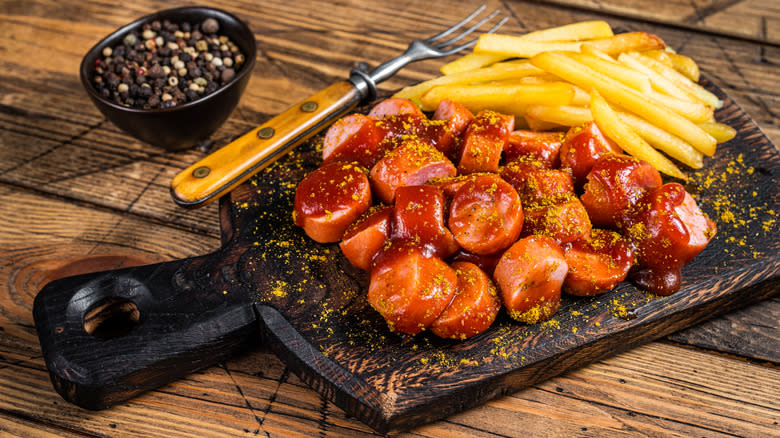
A popular fast food option throughout Germany, often enjoyed with beer, currywurst is exactly what it sounds like: curried bratwurst, or sausage. It's said that the snack came out of a woman's kitchen in Berlin back in 1949. As National Geographic tells it, Herta Heuwer covered sausage (a German staple) with a mixture of tomato paste, curry powder, and Worcestershire sauce. Other variations skip the Worcestershire sauce and combine ingredients like balsamic vinegar, turmeric, ginger, garlic, or cloves with the tomato base.
A truly iconic Berlin street food, it's typically made with grilled bratwurst, a sausage containing pork, beef, or a combination of both. Although that's the classic way to go about it, there are also vegan and vegetarian versions. No matter what sausage is grilled, boiled, or sliced, the key component of this resourceful and tasty dish is the curry sauce. While the blend of German cuisine and curry might seem rather unusual, this curry isn't much like Indian curry. It's more like a spiced ketchup-like sauce.
Schwarzwälder Kirschtorte (Black Forest Cake)
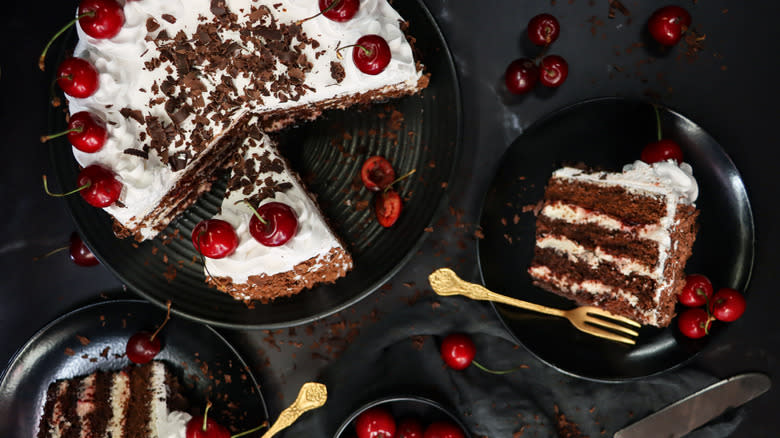
Also known as Black Forest cake, Schwarzwälder Kirschtorte is a traditional German dessert that is said to have originated in the Black Forest region in Baden-Württemberg, known as Der Schwarzwäld in German. As well as the dark coloring from the chocolate cake, for some people, the name inspires the mystique of waldeinsamkeit. This is the sublime and stress-relieving German concept meaning "the feeling of being alone in the woods." The second part of its name, kirschtorte, simply means "cherry cake." These traditional flavors of rich chocolate and tart cherries are essential to the dessert.
While historians believe the cake dates back to the 16th century, later recipes appeared closer to the early 1900s. According to What's Cooking America, the dessert gained quite a bit of popularity by 1949. When going off the original recipe, a classic Black Forest cake is made with a decadent chocolate sponge moistened with kirsch, a cherry brandy, or cherry syrup. Part of what makes Black Forest cake unique is the layer of cherries — either fresh or, more commonly, sour cherries in a syrup or compote form. Finally, the cake is usually topped with whipped cream and chocolate shavings.
Kartoffelpuffer (Potato Pancakes)

German potato pancakes, known as kartoffelpuffer, are a popular comfort food. They make a wholesome breakfast but can be enjoyed at any time of day. Traditionally, these are eaten during the winter months, especially in Christmas markets and during holiday festivities. In Germany, they are often served with applesauce or sour cream on the side, creating a contrast of savory and sweet or sour flavors. Other local variations include serving it with German quark, a soft cheese, smoked salmon, liverwurst, or any garnish other than applesauce. Beyond Germany though, further variations of potato pancakes exist in many countries, each with its unique touch.
The German-style kartoffelpuffer stands out for its hearty simplicity and comforting, crispy texture. It's made with grated potatoes, grated onions, salt, and pepper, plus an array of spices and herbs for extra flavor. To bind the mixture together, it's also combined with a batter of flour and eggs. Portions of the batter are then flattened and pan-fried in oil or butter until both sides are crispy and golden brown. In a way, they are similar to latkes, but latkes are different to potato pancakes — kartoffelpuffer requires thinly sliced potatoes instead of the thicker, grated pieces used in latkes. The binding ingredients can also vary.
Bratapfel (Baked Apple)
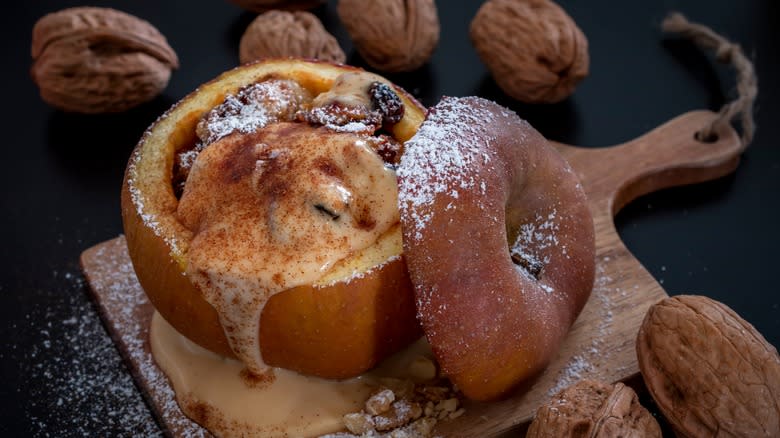
Bratapfel, or baked apple, holds a special place in German holiday traditions, especially during the Advent season leading up to Christmas. According to folklore, the stuffed, baked golden apples are meant to symbolize the gold bags that St. Nikolaus inconspicuously brought to a poor man. This same tale is sometimes regarded as the root story of the original gifts delivered by Father Christmas. Holidays aside, German baked apples are a simple and delicious dessert that can be enjoyed throughout the year.
The star of the dish is a robust apple, ideally a baking apple, like Braeburn. First, the apple is carefully cored, leaving the base intact. It's then filled with a mixture of ingredients before being baked in a hot oven until soft and warm. Common fillings for bratapfel include a blend of raisins, chopped nuts (like almonds or walnuts), sugar, cinnamon, and sometimes marzipan or amaretto. This cozy dessert is frequently accompanied by a drizzle of warm vanilla sauce or custard, a scoop of vanilla ice cream, or a dollop of whipped cream.
Eisbein (Corned Ham Hock)

Eisbein, also known as schweinshaxe, is a traditional German dish made from the pork knuckle or ham hock — the lower part of a pig's leg. This hearty dish has a significant cultural presence throughout Germany, from Bavaria to Berlin. It's often associated with beer culture and is a popular dish in beer gardens and traditional German restaurants, as well as during festivals like Oktoberfest.
First, the pork knuckle is usually salt-cured or brined to impart flavor and preserve the meat. Then, it's typically slow-cooked by either boiling or roasting until the meat becomes tender and easily falls off the bone. How it's cooked largely comes down to where it's made. In the northern parts of Germany, it's apparently boiled after it's cured. Meanwhile, in the southern part of the country where it's called schweinshaxe, it's usually roasted or grilled. Sometimes the meat is marinated, but it's often seasoned with a unique blend of herbs and spices such as garlic, bay leaves, marjoram, juniper berries, and caraway seeds. Traditionally, it's paired with side dishes like sauerkraut (Germany's iconic fermented cabbage), kartoffelpüree (mashed potatoes), or erbspüree (mashed peas).
Zwiebelkuchen (Onion Cake)
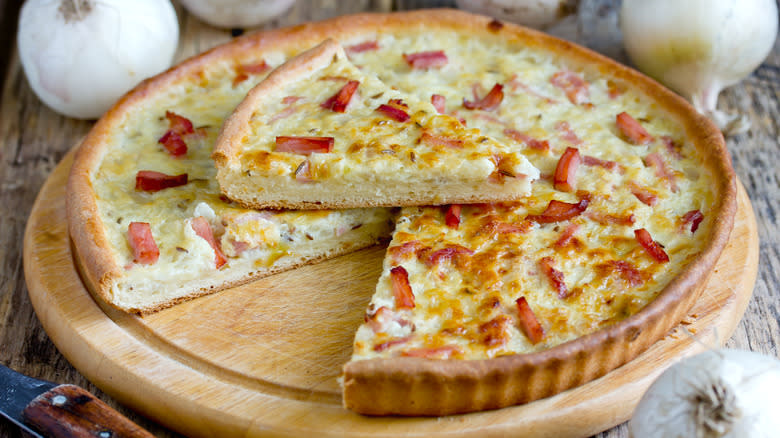
During the harvest and wine season of Germany in October, zwiebelkuchen is a classic dish often enjoyed at weinfests. Literally meaning "onion cake," the savory dish is almost always paired with federweisser, a fermented white wine that translates to "feather white." The traditional version of this dish is from the Schwaben region and is more like a deep-dish tart or quiche than a cake. This wholesome baked dish is made from a yeast dough loaded with caramelized onions, cream, eggs, and sometimes caraway seeds, bacon, or small pieces of ham. Traditionally, zwiebelkuchen is served warm with a glass of federweisser.
Germany is home to a few other, similar baked dishes, some deep, like pies, and others thinner, more like flatbreads. One, flammkuchen, is much thinner, sometimes called German pizza. It includes sour cream and thinly sliced bacon in addition to onions, and is usually cut into squares before being served.
Schweinebraten (Roast Pork)
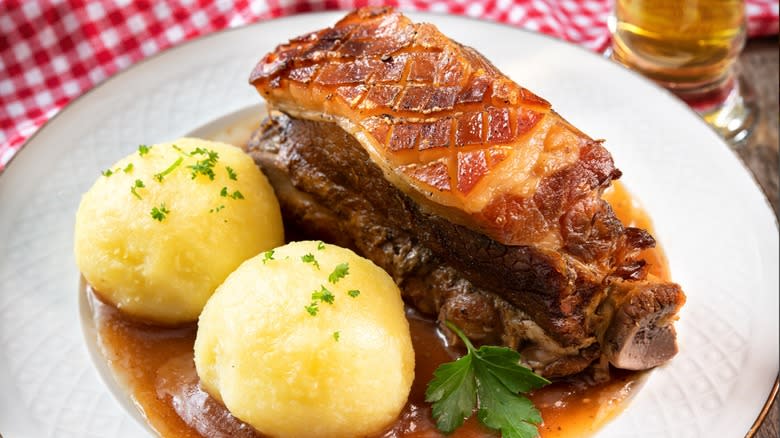
Essentially the German version of roast pork, schweinebraten is deeply ingrained in German culture and is often served at family gatherings, special occasions, and during Oktoberfest. Originally, this dish is Bavarian, and the traditional recipe involves slow-roasting pork in beer. Beer isn't necessarily required though, and you can easily make this recipe your own while keeping it true to the original by incorporating spices regularly found in German cuisine, like caraway seeds or marjoram.
Various cuts of pork can be used for schweinebraten, including shoulder, loin, or leg. Like most pot roasts, this dish is all about the seasonings and the slow cooking, with the pork typically marinated in a mixture of spices and herbs, such as garlic, paprika, caraway seeds, marjoram, and thyme. After marinating, the pork is roasted in the oven alongside a bed of vegetables like carrots, onions, and celery with beer as the liquid base to add flavor and depth. While it's slow cooking, the pork develops a crispy, flavorful crust on the outside while retaining its juiciness on the inside.
Knödel (Dumplings)

Knödel is a fundamental and versatile dish in German cuisine, known as dumplings in English, but not to be confused with the stuffed kind. These bread-based dumplings are a staple in German cooking, particularly in Bavaria, with several innovative variations. Typically, these dumplings are made from a mixture of stale or dried bread, eggs, milk, and seasonings like salt, nutmeg, and parsley. After the mixture is shaped into round dumplings or balls, they are either boiled or steamed until they expand and become fluffy, which results in a soft and slightly chewy dumpling.
Also known as klösse, this classic dish comes in several forms, such as semmelknödel (made from white bread rolls), kartoffelknödel (potato dumplings), brezenknödel (made from pretzels), and marillenknödel, a dessert version filled with apricots and coated with buttery breadcrumbs or cheese dough and powdered sugar. As for the savory dumplings, they can be eaten as a side dish, often accompanying meat-based dishes like schweinebraten, or served with rich sauces and gravies. For instance, semmelknödel is usually paired with meat and gravy and kartoffelknödel goes well with roasts and stews. Just like most German food, knödel started as a resourceful way to use ingredients like old bread, and every variation is a perfect example of German innovation and adaptability with whatever ingredients are on hand.
Käsekuchen (Cheesecake)
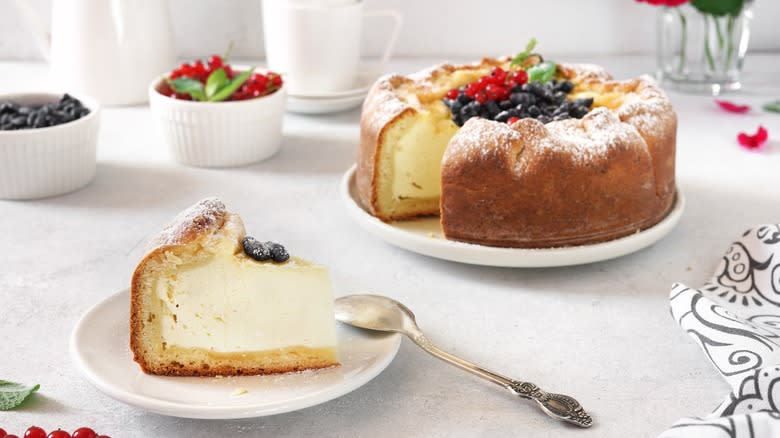
Just about every country has its own take on cheesecake, and Germany is no exception. Their cheesecake, called käsekuchen, is somewhat lighter than American cheesecake but not quite as characteristically fluffy as Japanese cheesecake. Instead of cream cheese, käsekuchen is made with quark, a tangy, soft cheese made of buttermilk and regular milk that's easily available in Germany, Austria, and Switzerland. The German dessert also incorporates lemon and vanilla for extra sweetness and is garnished with fresh fruits like berries, cherries, or peaches. Usually, the base of the cake consists of a yeast dough, pastry or cookie crust, or even sponge cake.
Regionally, the dessert can vary slightly. In Dresden, Saxony, the Dresdner eierschecke is a specialty that consists of three layers: a shortcrust pastry, a layer of quark cream, and a layer of egg custard. Variations include kirsch käsekuchen, which is a cherry cheesecake, while some versions have added ingredients like chocolate or sour cream. Like most cheesecakes, this dessert is best served chilled with whipped cream or ice cream.
Eintopf (Stew)

Reminiscent of simpler times when people cooked using whatever was available, eintopf was especially popular during times of war when resources were limited. Directly translating to "one pot," this dish is a traditional and hearty recipe that embodies the simplicity, versatility, and comfort of German cuisine. The stew can be made using a variety of ingredients, including meat, such as ground beef, pork, chicken, or sausages; vegetables like potatoes, cabbage, carrots, and onions; legumes such as peas or lentils; and grains, like barley or rice. Seasonings are interchangeable, but traditional herbs and spices like nutmeg and caraway seeds are typical in any German cuisine, this stew included. The point of this recipe was to always use whatever was available in your home pantry, as a way to create something filling and frugal.
Across Germany, the recipes for eintopf vary. For example, graupeneintopf uses barley grains, while westerwälder kartoffeleintopf incorporates sausage and potatoes. During Lent, when avoiding meat, a root vegetable stew called wurzelgemüse-eintopf is common. While traditional eintopf is still widely enjoyed, modern adaptations have evolved, with contemporary chefs and home cooks experimenting with different ingredients, in their one-pot stews.
Rouladen (Roulades)
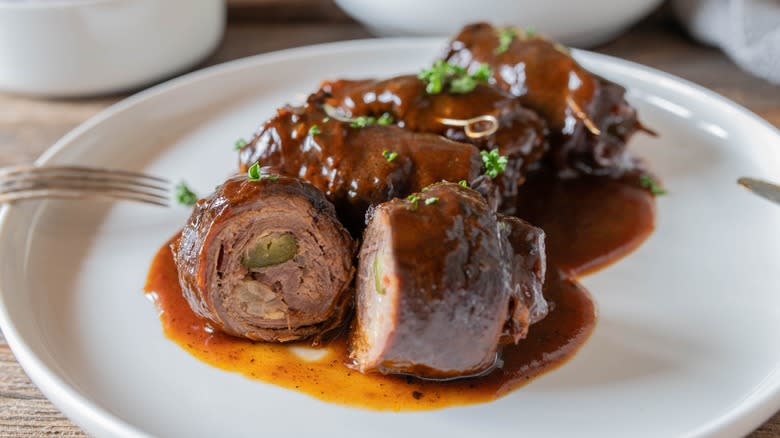
Beef roulades, called rouladen or rinderrouladen in German cuisine, are a fine example of "peasant dishes" that exemplify Germany's economic culinary traditions. Nowadays, because it takes some time to assemble, rouladen isn't prepared as regularly as other hearty dinner meals, such as schweinebraten. Still, the recipe is a staple in Germany and blends many of their favorites into one literal roll.
If you aren't familiar with the concept, roulades are thin cuts of meat rolled around various ingredients, be it cheese, vegetables, or even other meats. For German rouladen, the popular meat of choice is thin slices of beef from the top round that are generously seasoned. When preparing traditional roulades, you first spread a layer of German mustard, then add German pickles, onions, and bacon before rolling them tight enough to hold their swiss-roll shape. The dish is then seared until thoroughly cooked and usually covered with a savory gravy with sides like knödel or spätzle. Like most versatile recipes, rouladen comes in different versions, from sweeter recipes to vegetarian ones, like kohlrouladen, which is made with cabbage and popular in Berlin.
Read the original article on Daily Meal.

